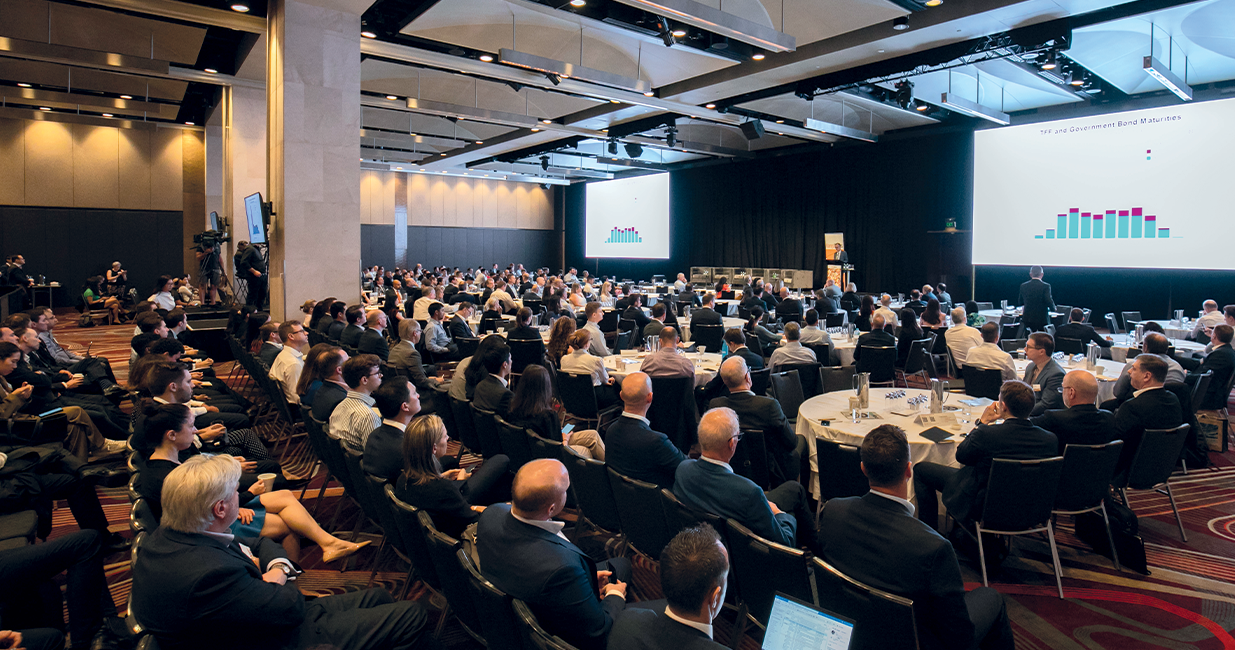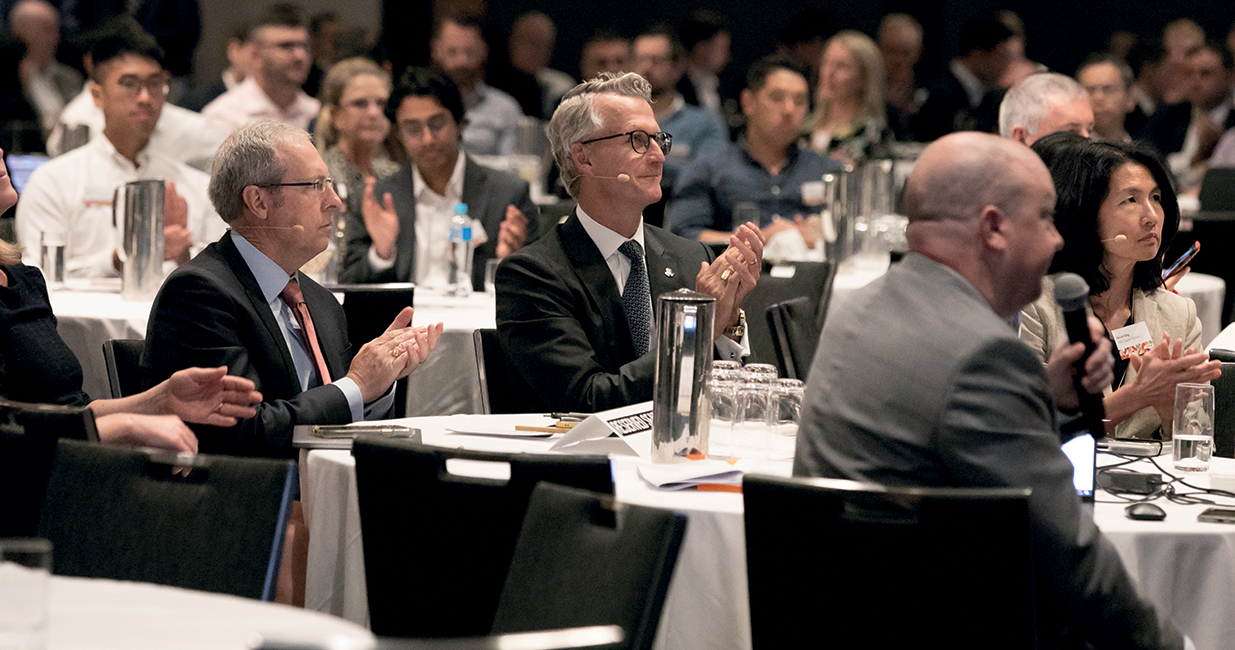
Australian market takes stock of new inputs
Conversations at the KangaNews Debt Capital Market Summit, which took place in Sydney on 20 March, naturally focused on the fallout from bank collapses that immediately preceded the event. The overall view was that relatively positive conditions in the fixed-income market would be reshaped but perhaps not fundamentally weakened by the emerging developments.
“Only one-third of households have a mortgage and the cash flow channel is only one way in which higher interest rates affect the economy. Ultimately, what matters for demand and inflation is how businesses and households overall respond to higher interest rates through all the channels of monetary policy.”
“The biggest worry in the mortgage and consumer lending markets is normally unemployment leading to defaults. This time around, the change in rates from mortgages shifting to variable from fixed rate could actually make borrowers stressed purely by the payment shocks – to the extent that borrowers might still be employed and yet be unable to afford all the liabilities they have taken on.”

“The UK has been experiencing a very profound cost of living crisis that definitely adds to expectations of growing arrears and default. We don’t expect a wave of forced sellers, but what makes us nervous is the Q3 2022 cohort of two-year fixed mortgages that will be forced to refinance in 2024. Risk is also increased because the UK has entered a downward housing market trend – we expect it to correct by 10-12 per cent over the next two years.”
“The international bid has traditionally been very significant in our Kangaroo books, dominated by central banks. Domestic banks are now picking up to some extent. Last year, we had about 78 per cent international investors in our Australian dollar issuance. It is now down to 64 per cent – still a very high number but domestic investors are also picking up. I’m happy to see this.”

“They say in the military that no plan survives contact with the enemy. We have had this contact with Credit Suisse and Silicon Valley Bank, and it has completely changed the narrative on rates trajectory. It has definitely re-priced the story that central banks will do whatever they have to do to beat inflation. But the
overshoot to the downside in pricing is likely a little unrealistic.”
“Structural demand for duration appears still to be there. One of our theses for this year is that last year’s duration macro story is this year’s credit story. In other words, it is about credit selection, idiosyncratic credit events and understanding which sectors investors might be overweight and underweight. Recent events have created some understandable volatility: a financial crisis is not an idiosyncratic credit event – it feeds through to corporates and the whole economy.”
WILL MANFIELD
“We have seen a growing disparity in the local credit market this year as financial institution supply, including securitisation, boomed while the true corporate market was only just starting to revive after what was a pretty quiet and lifeless 2022. It now appears to be sidelined again. This is clearly relevant to the secondary market, where corporate paper is typically tightly held and illiquid.”
“We anticipate issues in the REIT sector, in particular office property – in fact we have the most focus on this sector we have had since the global financial crisis. We are certainly not saying we are back in crisis conditions, but it has been a fairly benign sector for the past decade or so since the financial crisis and it is obviously very sensitive to higher interest rates and other structural risks, such as hybrid working.”

“A lot of corporates were relieved the bank market worked well for them last year, and I didn’t hear of any corporate treasurers who were dying to get sign off for a bond transaction at what would have been significantly higher rates and spreads than boards were used to seeing. For the most part, the lack of corporate supply last year was a function of the bank market working well.”
“We were contemplating a capital market transaction last year, having completed a sustainability programme. Then conflict in Ukraine started and pricing progressively got worse for us. As a treasurer, I am inevitably very price sensitive – so we ended up exploring a syndicated loan
facility based in Asia.”

“The quality of office space has come into question because of the hybrid working model. Some of the quality REITs have upped their game regarding high-quality facilities and green credentials. But there will be losers – probably at the lower-quality end. This will have knock-on effects through revaluation, which matters for gearing.”
HELEN MASON
“The superannuation industry is subject to the performance test, but this actually gives us a lot more opportunity to pursue active fixed-income strategies rather than leaning into passive strategies. The fear has been that funds will just hold the benchmark in an attempt to satisfy the test. But I think, in reality, there will be more uptake of active strategies as a result of these changes.”
“Scale lets an investor build expertise and access opportunities that would otherwise not be available. It allows us to construct a very well-diversified portfolio from a return but also an asset perspective, such that we are well positioned to be resilient through various market conditions. We are not beholden to one market if it is in strife.”

“Contemplating global decoupling is really, really hard for businesses and investors because China is not an option for a lot of them – it is essential. It’s the biggest market, of course, with great people and great companies. But balancing this with the risk of doing business there as in the past is going to be very difficult. We are seeing the response coming with the diversification of supply chains, such as Apple setting up factories in India. We will see companies moving their factories to Thailand, Malaysia, Indonesia and the prime beneficiary in south-east Asia so far – Vietnam.”
“As we head into this era of the climate disaster, Indonesia and Malaysia are potential climate superpowers. There is a lot of opportunity to think about in those countries when it comes to investment in creating carbon and other environmental credits that will be needed to get to net zero. But there is also tax risk in investing in these areas. We really need to start doing country deep dives, to understand the risks that come with the opportunities from the transition to net zero in markets across south-east Asia in
particular.”
“One of the themes of the social and governance aspects of ESG is that they cannot really be offset. Even on the environmental side, we are perhaps starting to see less tolerance for companies ‘just’ offsetting their environmental footprint with carbon credits. There is certainly a lot more rigour emerging in this space.”
“Our level of activity in Australia is reflective of how attractive the market has been for offshore issuers. The tightening trend in US dollars means this has been the only market that has really been competing with the attractiveness of Australian dollars for issuers. Otherwise, there have been pockets of attractive funding in sterling while New Zealand dollars has had a few episodes of being quite competitive versus US dollars.”
“It became obvious last year that a public transaction in the Australian domestic market was going to be difficult, particularly when it came to pinpointing pricing. Our approach was to tap into private placement opportunities from reverse enquiry – we had support to be confident on exact pricing and the ability to execute accordingly.”
“It is hard to be bullish in an environment where rates are going up and corporates are refinancing at high yields. Investors will probably play defensively, including keeping tenor short at 3-5 years. Fortunately, this allows SSAs and financials to play in in a market where there is clearly a lot of cash.”
“We had a very constructive start to 2023. Momentum built quickly, in the credit space for financials and in rates for SSAs and semi-government issuers. This led to a very constructive 8-10 week period of new issuance, featuring a steady compression in credit spreads and heavily oversubscribed books. We are up to about A$55 billion of supply year-to-date, which is about 40 per cent more than last year.”
“We don’t know exactly what higher interest rates will ultimately mean in the economy. No-one has a crystal ball so it is important to have conservative, balanced settings. If we focus on asset-liability management, uncertain rates shouldn’t be an issue. More broadly, it fundamentally comes back to strong capital and a strong provisioning base to support our business.”
“All the Australian banks are very active in hedging interest rate risk. This is something we have actively managed for a long time. We also have a pretty unique regulatory regime, including modelling of broader interest rate risks. There are not many jurisdictions where this is so explicit, but it is in our pillar-one capital requirements.”

“The Queensland government has committed its balance sheet to some big initiatives, including a detailed blueprint for energy transition. This is a 13-15 year plan worth A$62 billion that includes two major pumped hydro energy storage systems, expansion of the state’s high voltage transmission network and significant investment in renewable generation – where private investment is being encouraged. The challenge is ahead of us and our focus is on least-cost transition.”
LEON ALLEN
“The key for us is to establish our formal ESG framework to bolster our reporting to investors. We have been engaging with investors and banks globally for quite some time, with the end goal of having a formal framework established to make sure we are set up for future changes in this space.”
ANTHONY COATES
“We recently did a substantial amount of investor outreach during which the level of interest in Treasury indexed bonds was quite a surprise for me, based on the size of the programme. Given we had committed to planned issuance of A$2-2.5 billion for the year, we have spent a lot of time talking about it. There is more engagement we can do with intermediaries and investors.”
“Offshore has always been a focus for us to diversify our investor base. There has been some slowing of appetite from Japan but we are also experiencing good appetite from European accounts and from domestic real money. Some of the pickup is about the value semi-governments offer relative to Commonwealth bonds – spreads of 70-90 points at 10 years.”
“Globally, we split out all liquidity risk from interest rate risk – everything is swapped back to a floating rate and the interest rate risk is then moved internally to the interest rate book. We find that if something is going wrong, it is probably going wrong in multiple markets at the same time.”
“Our book is predominantly floating rate. We have a liquids portfolio, predominantly floating rate or swapped back into floating, but it is a banking book – it is not a trading book. Japanese banks are typically quite conservatively focused. Having said this, we would not completely rule out the opportunity to buy fixed rate.”
“The granularity and overall size of domestic books we saw over January and February was very strong. This is not just the Australian component but other investors as well – which we see as a sign of maturity of the Australian market. We are also able to do multitranche domestic transactions, which is a strong sign of differentiation.”
“During the TFF era we had much less demand for funding. We did have some near-fill maturity gaps and we did a two-year covered bond in March in Europe, which worked really well in a time of volatility and suited our maturity profile. We have done a little more two-year issuance than in other years; generally three- and five-year is the sweet spot.”
“The banks took very, very large loss reserves at the outset of the pandemic and they are still fairly elevated relative to pre-pandemic times. We can see the way the banks have adjusted some scenario weightings for downside risks to the economy and what this means for loss reserving. This has been quite helpful.”
“Central banks’ fiscal and monetary stimulus post-pandemic spurred a flood of money, which was appropriate with regard to the global economic environment and has really stabilised things. But for the financial system, and for banks in particular, it has created some complications about managing excess liquidity.”
“It is important to keep in mind that 2022 was a pretty rough year for fixed-income investors, with double-digit losses on their portfolios. One of the upsides of the increase of central bank interest rates, however, is the return of fixed income as a genuine asset class including quite attractive all-in yields.”
“The Australian banking cohort has been extremely active over the past five or six months with, by our count, about A$75 billion in term funding executed. Many will feel they are ahead of where they need to be. Core global currencies have all been used and have delivered size and optionality. Meanwhile, there has been new issuance right across the capital structure.”


HIGH-GRADE ISSUERS YEARBOOK 2023
The ultimate guide to Australian and New Zealand government-sector borrowers.

WOMEN IN CAPITAL MARKETS Yearbook 2023
KangaNews's annual yearbook amplifying female voices in the Australian capital market.

SSA Yearbook 2023
The annual guide to the world's most significant supranational, sovereign and agency sector issuers.







